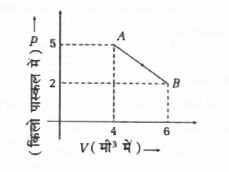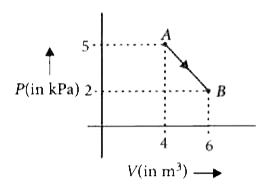One mole of an ideal diatomic gas undergoes a transition from A to B along a path AB as shown in the figure, The change in internal energy of the gas during the transition is:Solution in Gujrati
20 kJ
−20 kJ
20 J
−12 kJ
The correct Answer is:B

ΔW=nCVΔT ….(1)
but ΔT=T2−T1
=P2V2nR−P1V1nR[∵T=PVnR]
=P2V2−P1V1nR
Putting this value in equation (1),
ΔU=nRγ−1(P2V2−P1V1nR) (∵CV=Rγ−1)
=P2V2−P1V1γ−1
=(5×4−2×6)×10335−1 (∵γ=35)
=(20−12)×103−25
=−8×1032×5 =-20 kJ
Topper's Solved these Questions
- THERMODYANMICS BOOK - KUMAR PRAKASHANCHAPTER - THERMODYANMICS EXERCISE - Section-F Questions from Module
20 Videos
- THERMODYANMICS BOOK - KUMAR PRAKASHANCHAPTER - THERMODYANMICS EXERCISE - Question Paper
11 Videos
- THERMODYANMICS BOOK - KUMAR PRAKASHANCHAPTER - THERMODYANMICS EXERCISE - Section-D Ncert Exemplar Solution (Long Answer )
5 Videos
- THERMAL PROPERTIES OF MATTERBOOK - KUMAR PRAKASHANCHAPTER - THERMAL PROPERTIES OF MATTEREXERCISE - Question Paper (Section - D) (Answer following in brief :) Each carry 4 marks
1 Videos
- UNITS AND MEASUREMENTBOOK - KUMAR PRAKASHANCHAPTER - UNITS AND MEASUREMENTEXERCISE - Section -F (Questions from Module )
20 Videos
Similar Questions
In a thermodynamics process which one of the following statement is not true ?
View SolutionWhy is a steam burn more damaging than a burn with boiling water of the same ?
View SolutionConsider a P-V diagram in which the path followed by one mole of perfect gas in a cylindrical container is shown in figure.

(a) Find the work done when the gas is taken from state 1 to state 2.
(b) What is the ratio of temperature T1T2 if V2=2V1 ?
(c) Given the internal energy for one mole of gas at temperature T is 32RT, find the heat 2 supplied to the gas when it is taken from state 1 to 2, with V2=2V1
View SolutionIn an experiment on the specific heat of a metal, a 0.20 kg block of the metal at 150∘C is dropped in a copper calorimeter (of water equivalent 0.025 kg) containing 150 cm3 of water at 27∘C. The final temperature is 40∘C. Compute the specific heat of the metal. If heat losses to the surroundings are not negligible, is your answer greater or smaller than the actual value for specific heat of the metal ?
View SolutionIf the error in measurement of radius of a shpere is 2% then the error in determination of volume of the sphere will be …………
View SolutionOne mole of an ideal diatomic gas undergoes a transition from A to B along a path AB as shown in (figure). The change in internal energy of the gas during the transition is (gamma=3//5)
View SolutionOne mole of an ideal monoatomic gas undergoes a cyclic process as shown in figure. Then the change in the energy in expanding the gas from a to c along the path abc is:
View SolutionOne mole of an ideal monoatomic gas is caused to go through the cycle shown in figure. Then, the change in the internal energy is expanding the gas from a to c along the path abc is:
View SolutionOne mole of an ideal diatomic gas undergoes a transition from A to B along a path AB as shown in fig. The change in internal energy of the gas during the transition is (gamma =3/5)
View SolutionOne mole of an ideal diatomic gas undergoes a transition from A to B along a path AB as shown in the figure, The change in internal energy of the gas during the transition is :
View SolutionOne mole of an ideal diatomic gas undergoes a transition from A to B along a path AB as shown in the figure

The change to internal energy of the gas during the transition is
View Solutionएक आदर्श द्वि-परमाणुक गैस के 1 मोल का, AB पथ के अनुदिश, A से B टकल संक्रमण होता है।

इस संक्रमण के दौरान गैस की आन्तरिक ऊर्जा में परिवर्तन होगा
View SolutionOne mole of an ideal diatomic gas undergoes a transition from A to B along a path AB as shown in the figure. The change in internal energy of the gas during the transition is

View SolutionOne mole of an ideal diatomic gas undergoes a transition from A and B along a path AB as shown in the figure The change in internal energy of the gas during the transition is
View SolutionOne mole of an ideal diatomic gas undergoes a transition from A to B along a path AB as shown in (figure). The change in internal energy of the gas during the transition is (gamma=3//5)
View Solution
